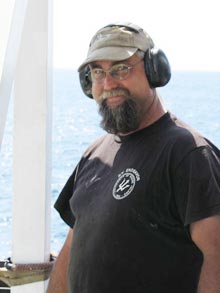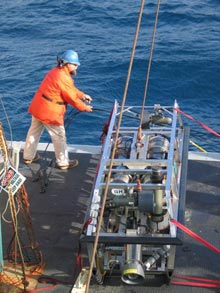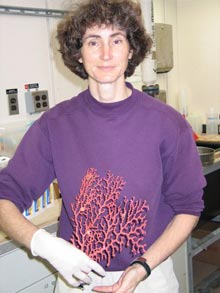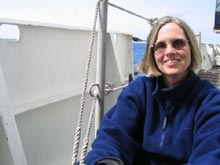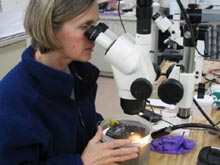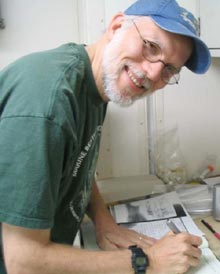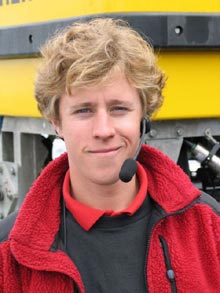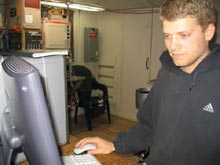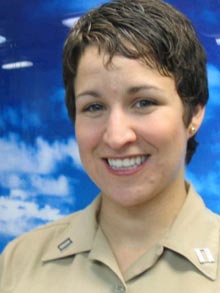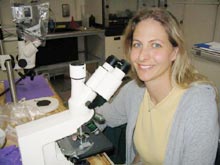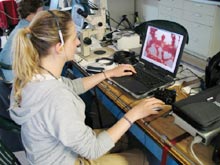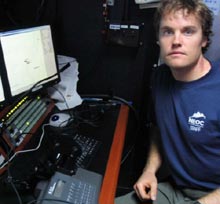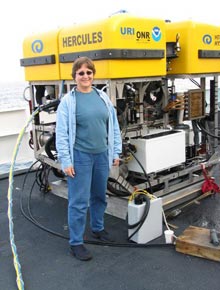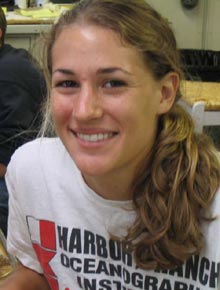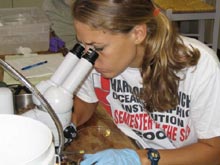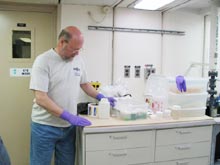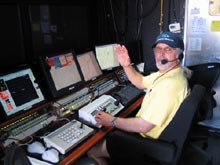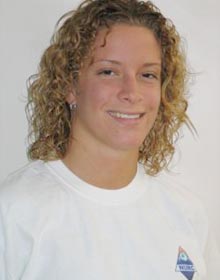Interview with David Owen
Interview by Lance Arnold of the Ocean Explorer Team
Ocean Explorer: What is your job and what does it entail?
David Owen: I assist the bosun in managing the Ronald H. Brown deck department. This entails every aspect of the work, from basic ship preservation (such as removal of rust and painting) to personnel management. I can operate all the deck equipment and am approved to train others in its use. Deck equipment includes the hydrographic boom, cranes, capstans, winches, such as the CTD winch, and rescue boats. I maintain the deck and hazardous material inventories, the material safety data sheets, and the safe working load tests on equipment. I’m also the deck department purchasing agent.
Ocean Explorer: Do you need to take tests for these skills?
David Owen: Yes, on some. There are tests for all of the major equipment items and for the boats. There is a test for the “rescue boat coxswain.”
Ocean Explorer: What are your tasks for the Mountains in the Sea expedition?
David Owen: I assist in the deployment and recovery of the ROV [remotely operated vehicle] Hercules and do maintenance and operation of deck equipment, such as the air-tuggers.
Ocean Explorer: Okay, David. What’s an air-tugger?
David Owen: The air-tugger is a pneumatic winch used to maintain the stability of the ROV Hercules, or other science packages, when recovering them from the sea.
Ocean Explorer: How did you become interested in doing this kind of work?
David Owen: I was raised in the Miami/Florida Keys area, and my father and mother taught me how to work hard. My grandfather was a boat builder, and I would help him build boats. I started sailing as a teenager and joined the Navy in 1976. Later, I worked at marine boat companies, which make cigarette-type boats such as Magnum and Aranow, which are go-fast boats. In 1990, I joined NOAA and have worked on three vessels: the Malcolm Baldridge, the Whiting, and the Ronald H. Brown, where I am currently employed.
Ocean Explorer: What would you like to say to students?
David Owen: Take summers and get out on a variety of vessels to see if you are "one with the sea." And enjoy the work.
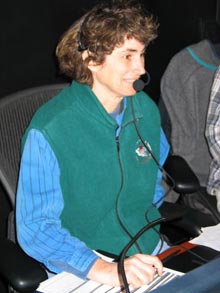
Dr. Lauren Mullineaux, senior scientist and H. W. Jannasch chair, Woods Hole Oceanographic Institution.
Interview with Lauren Mullineaux
Interview by Lance Arnold of the Ocean Explorer Team
Ocean Explorer: Dr. Mullineaux, what is your educational background?
Dr. Lauren Mullineaux: I went to Pamona College in Southern California, looking at desert ecology. One semester, I participated in a program run by the Sea Education Association in Woods Hole, Massachusetts. I spent some time on the two-masted schooner Westward, and though often seasick, I enjoyed it so much that I decided to make a career out of marine science.
Ocean Explorer: Why are you on this trip?
Dr. Lauren Mullineaux: I’m interested in the dispersal and colonization of organisms, particularly deep-water soft corals, into new habitats. As seamounts are rocky islands in a sedimented sea floor, I wondered how these organisms dispersed from seamount to seamount.
Ocean Explorer: How do you study this?
Dr. Lauren Mullineaux: Coral larvae are difficult to catch and identify in the water column, so instead we catch them when they settle out onto a rocky surface that mimics their natural habitat. We try to determine how often they settle out.
Ocean Explorer: Don’t all the larval forms look pretty much the same?
Dr. Lauren Mullineaux: Yes, coral larvae do look somewhat alike, but only because we haven’t looked at them enough. Once a larva has settled, we can look at the polyp form and hard bits, called sclerites, that support the soft tissue. Others can look at its DNA sequences, which are unique to each species.
Ocean Explorer: How do you find pieces of rock with larvae settled out?
Dr. Lauren Mullineaux: First, we use a technique that we have used at hydrothermal vents for 10 years or more. We cut pieces of basalt, which is the natural rock of the seamount, and leave it for larvae to settle on over a period of time. Then, we return to pick them up and see what we’ve got. The reason we put our own blocks of basalt down is that lets us know the time window when larvae settle.
Ocean Explorer: So the blocks are raw basalt with nothing on them when you place them on the seamount?
Dr. Lauren Mullineaux: That’s correct.
Ocean Explorer: Have you done these recruitment studies on seamounts before?
Dr. Lauren Mullineaux: We’ve done this with Pacific seamounts, and we get lots of species, but we have never gotten a newly settled soft coral polyp.
Ocean Explorer: Why don’t you get these polyps?
Dr. Lauren Mullineaux: We think the soft corals colonize very rarely. Maybe they reproduce often, but are only successful in colonizing on a periodic basis.
Ocean Explorer: What would you like to say to female high school students?
Dr. Lauren Mullineaux: I encourage you to follow your curiosity and don’t worry about traditional roles and goals. Also, choose your spouse carefully!
Interview with Susan Mills
Interview by Mary Grady of the Ocean Explorer Team
Ocean Explorer: As a researcher at Woods Hole Oceanographic Institute [WHOI], what kind of work do you do?
Susan Mills: I work on a variety of projects, from studying corals on seamounts to collecting plankton above the hydrothermal vents on the East Pacific Rise, near 10 North. We collect the plankton from 175-meter-deep moorings. The trick is to identify them properly, because a lot of them look alike, especially at the larval stage. That's my specialty, and I have a lot of fun with that.
Ocean Explorer: What other work do you do at WHOI?
Susan Mills: Our most challenging project right now is studying the settlement of clam populations in Barnstable Harbor and the Neponset River. We're working on ways to identify the trace elements found in the clam shells so we can determine where the larvae have come from, and learn how the populations are inter-connected. It's difficult, and we can't do it yet, but that's our aim. I also don't have to be on a lot of committees. I do the hands-on science, which is what I like. Once we get back from a project, then we write up the data and publish papers, which can take a long time.
Ocean Explorer: Do you work with students at all?
Susan Mills: I don't teach classes, but we do have MIT [Massachusetts Institute of Technology] grad students who come to work in our lab. I interact a lot with them.
Ocean Explorer: What is your favorite part of your job?
Susan Mills: My favorite part really is microscope work. A lot of people don't like that, but I do. A lot of the stuff we bring onboard here is all new, so there's a good chance to find something interesting. Then putting it all together is like a jigsaw puzzle. It's a challenge, and I love it.
Ocean Explorer: How did you get to this point in your career?
Susan Mills: As an undergraduate at Brown University, I knew I was interested in doing biological research. I took a course in marine biology, and they brought us out to the MLB [Marine Biological Laboratory], in Woods Hole. Working with the animals there was just the coolest thing I had ever done. So I went on to graduate school at Boston University's Marine Program, and the most fun part for me was the hands-on science. That led me into working at MBL, and I loved it. I stayed there until 1992, when I went to work at WHOI.
Ocean Explorer: How often do you go to sea on cruises like this one? Have things changed over the years?
Susan Mills: I usually go out about once a year or so—it depends. Back in 1982, I was on a cruise to the hydrothermal vents in the Pacific, and back then there was no way to even get a message home. But one day, Walter Cronkite came out to join us in a dive. We were able to send mail home with him when he left the next day in his boat. So it's really nice to have email on board and to be able to keep in touch.
Ocean Explorer: Is it tough to balance this kind of a career with a family at home?
Susan Mills: All of my work is grant supported, and I've never worked more than three-quarter time since I came to WHOI, which is what I prefer. I have two young children at home, 10 and 13, so I love to be able to be involved with them. I volunteer at my daughter's school, in the computer lab. During this cruise, they're home with their dad; and during the summers, I pay back by staying with the kids and he gets more time on his boat. So it all works out.
Interview with Dr. Jon Moore
Interview by Mary Grady of the Ocean Explorer Team
Ocean Explorer: How did you decide to follow a career in marine biology?
Jon Moore: As an undergraduate at the University of Arizona in Tucson, I was interested in geology and I thought I would be a paleontologist. But then I learned to scuba dive, and I saw all these fish, and I thought, "Those are really cool!" And I decided that what I wanted to do was to learn about fish. For a while, I thought I would concentrate on fossil fishes, but in grad school, at Yale University, I ended up working more with the living fish.
Ocean Explorer: On this expedition, you've amazed everyone with your encyclopedic knowledge of the fauna here on the seamount chain. How did you accumulate all of that information?
Jon Moore: While in grad school, I worked for five and a half years at Yale's Peabody Museum, while also teaching part-time. So I spent a lot of time classifying collections and essentially taught myself the taxonomy.
Ocean Explorer: What is your role on this science team?
Jon Moore: I actually have two functions. One is to document the distribution and behavior and the biogeography of the fish species we encounter. I have a theory that the New England Seamount Chain acts as a stepping-stone for the distribution of species from the eastern Atlantic to the western, and some of the data we've collected so far helps to support that theory. For instance, we've seen the white chimaera and oreos on several of the seamounts. These are considered eastern Atlantic species, and they are known to be found only in the western Atlantic in this New England region. My second function is to archive the specimens. I'm collecting for the Peabody Museum and the Smithsonian. I feel a real responsibility to make these specimens available to the scientific community.
Ocean Explorer: You've been diving in DSV Alvin before. How did you find working with the ROVs [remotely operate vehicles] compared to Alvin?
Jon Moore: This was my first time using an ROV, and I think both technologies have advantages and disadvantages. Actually, being there in Alvin gives you depth perception and clarity. Having been to the sea floor in Alvin helps me in interpreting these video images from the ROV. One real advantage of the ROV that I hadn't anticipated is that it allows several experts to view the imagery together and have real-time conversations about what we're seeing. I've found that very interesting and enlightening, and that's not possible when you're in Alvin.
Ocean Explorer: What will you be doing next?
Jon Moore: I teach at Florida Atlantic University's Honors College, an experimental program that emulates the small liberal arts college atmosphere within a state university. I'm also working on a project to create a digital library of the biodiversity of the seamounts, with lots of video and still images. Having the live colors of the specimens and also video of their in situ behavior is invaluable. I'd also like to see more of these seamounts. We've explored only a tiny fraction of what's here, and given the patchiness of what we've seen so far, there's a lot we haven't had a chance to see yet. I've been invited to go on some more cruises in this region, so I expect I'll be doing more of that.
Ocean Explorer: Do you think these seamounts are safe from exploitation?
Jon Moore: I don't see that there is much here that would attract commercial fishermen. But because the ecosystems here are so unique and interesting, I'd like to see some of them designated as Marine Protected Areas to preserve the beauty and biodiversity.
Interview with Todd Gregory
Interviewed by Lance Arnold, Tolland High School teacher
Ocean Explorer: Could you please tell us a little about your educational background and how you came hold your present position.
Todd Gregory: I received my undergraduate degree in Naval Architecture and Marine Engineering from the Webb Institute, then a Masters in Ocean Engineering from the University of Hawaii. There I met Jim Newman and Dave Wright, both members of Bob Ballard's engineering team, and that allowed me to go on two of his trips, one to the Great Lakes to dive in Lake Huron, and another to the Black Sea in Bulgaria.
After these experiences, they wanted me as a mechanical engineer to help design and build the latest ROV, Hercules, and join Bob Ballard's team and ROV crew.
While at sea, I work as an ROV pilot, and between dives as a technician for the mechanical and hydraulic aspects of the vehicles. Our time at sea is important to test the design of the vehicles and learn what works and what gives us troubles. Back on shore I work with Jim Newman to perfect the vehicles and to implement changes necessary for future expeditions. For instance, many of the parts were redesigned this past year to reach a new depth rating of 4000 meters for our Titanic leg of this summers operations.
Ocean Explorer: How is your time divided between being at sea and being on shore?
Todd Gregory: I'm six or seven weeks at sea, and then the rest on shore.
Ocean Explorer: Where do you do your shore work?
Todd Gregory: Todd Gregory: Bob Ballard is at the University of Rhode Island's Institute for Archeological Oceanography based at U.R.I.'s Narragansett Bay Campus. I split my time between engineering work in the office and working on the vehicles in the shop.
Ocean Explorer: Based on this trips result, what will you be looking to change?
Todd Gregory: Todd Gregory: We will be redesigning a few aspects of the vehicle systems. Some parts of the structural frame need strengthening and the tether connection between the two vehicles needs re-thinking. We also need to check for wear and tear and thoroughly clean the hydraulic system.
Ocean Explorer: What are the hydraulics used for?
Todd Gregory: They are used to power many parts of the system such as the thrusters, manipulators, pumps, water jets, drill, saw, and docking station.
Ocean Explorer: How much practice is required to fly the ROV Hercules?
Todd Gregory: You need to watch the experienced pilots and anticipate their moves before they make them…sort of silent back seat driving. You need a very good sense of the 3-D orientation of the Argus camera sled and the ROV, as well as the ships position up above, and you need to be able to do this from instrument readings and the few visual clues that you get. Essentially, you need excellent spatial and 3-D visualization.
Ocean Explorer: Any new concepts being considered?
Todd Gregory: Integrating AUVs (Autonomous Underwater Vehicles) into our operation will likely be our next challenge.
Ocean Explorer: What would you like to say to high school students?
Todd Gregory: As a high school student, try to approach math and science as tools. They are the means, not the end. I suggest you find a mentor or become an apprentice to someone who uses their hands and solves practical problems on a daily basis. This was very important for me as I worked with engineers and with the deck hands on boats. They taught me a wealth of practical knowledge that has meshed well with a good math and science background.
Interview with Webb Pinner
Interview by Mary Grady of the Ocean Explorer Team
Ocean Explorer: Webb, tell me about what you are studying at school.
Webb Pinner: I studied computer engineering at Virginia Tech, and finished there in 2001. I worked in IT [information technology] for a while, in D.C. and Colorado and Michigan, but jobs are scarce in IT right now. There have been so many layoffs. I've moved 24 times in the last eight years. Last year, I decided to go back to school, and URI [University of Rhode Island] was the only place I applied to, and I got in. I'm studying ocean engineering.
Ocean Explorer: How did you come to be on this expedition?
Webb Pinner: While I was at URI, I knew the vehicles were there, and I went to the control van and met [ROV pilot] Tom Orvosh. I asked if it would be possible to see the ROVs, and he told me to "ask that guy who just left, he was the one who designed it." And that guy was Jim Newman. I told Jim I would do anything to get involved with this project, whatever they needed. I'd drain hydraulic fluid, whatever. So, a few months later, he called and asked if I could work on this project.
Ocean Explorer: What is your role on the ROV team?
Webb Pinner: I'm computer support and a data logger, and I'm also one of the video technicians. I have drained hydraulic fluid, too, but it was voluntary. This is the first time I've ever been on a cruise like this.
Ocean Explorer: What comes next for you?
Webb Pinner: I'll be going along on the Titanic cruise. After that, I don't know. My fiance and I have six jobs between us, plus I'm going to school. So I'll go back to school in the fall. And I hope to keep working with Jim Newman.
Interview with Liz Jones
Interview by Mary Grady of the Ocean Explorer Team
Ocean Explorer: What is your job aboard the Ronald H. Brown?
Liz Jones: As part of the NOAA officer corps, I act as a representative of the captain on the bridge. Each of the officers stands two, four-hour watches on the bridge every day. During watch, I'm keeping an eye on the navigation, collision avoidance, and everything involved in the operation of the ship. I also act as the ship's coordinator with the science party.
Ocean Explorer: How are NOAA officers trained?
Liz Jones: All of us have at minimum a bachelor's degree in science, including two semesters of calculus and two semesters of physics. Once we're hired, we're sent to the United States Merchant Marine Academy in New York for three months. Then it's on-the-job training. All officers spend their first two years in the corps at sea, then rotate to land assignments within NOAA for three years.
Ocean Explorer: How did you get onto this career track?
Liz Jones: In high school, I started surfing. I really loved the beach. My school counselor [in Worcester, Mass.] tried to steer me toward marine biology, but I didn't want to do that. Dissecting starfish just wasn't my thing! I went to Massachusetts Maritime Academy and studied marine safety and environmental protection.
Ocean Explorer: How long have you been with NOAA, and where have you been?
Liz Jones: I've been with NOAA about five and a half years. I spent two years in the Pacific, on a ship out of San Diego. Then I worked for three years on shore at Silver Spring, Md. I just joined this ship in March, so I'm pretty new here. Later this year, we'll be going through the Panama Canal, down the coast of South America, around Cape Horn, and back. On average the ship is at sea for 240 days each year.
Ocean Explorer: How do you like working for NOAA?
Liz Jones: NOAA is a multi-multi-faceted agency and offers a very dynamic career path. There are lots of opportunities to learn and do new things. I get to see exciting places and to play a very important role in the collection of data at sea. This is everything I ever wanted to do.
Interview with Anne Simpson
Interview by Lance Arnold of the Ocean Explorer Team
Ocean Explorer: Anne, what’s your educational background, and why are you on this trip?
Anne Simpson: I received a BS in biology from Mary Washington College. I was always interested in marine science so I went to the University of Maine and completed a MS in oceanography. I am now pursuing a PhD in marine biology at the University of Maine. I am on this trip to collect deep-sea corals to examine their reproductive biology. More specifically, I’m going to preserve tissues for light and electron microscope studies of coral reproductive morphology. I will also take video and digital still images of live polyps and measure the number and size of mature eggs.
Ocean Explorer: What kind of reproduction do octocorals have?
Anne Simpson: We know from studies of tropical shallow-water corals that some reproduce both sexually and asexually. I’m interested primarily in sexual reproductive strategies. Many shallow-water gorgonian corals reproduce by broadcast spawning. In other octocorals, such as those in family Xeniidae, fertilization occurs in the female colony and larvae are brooded for a period of time before being released. Much less is known about reproduction in deep-water corals. Since the days of the HMS Challenger expedition, scientists have recorded observations of eggs and even sperm structures in deep-water octocoral polyps; however, almost nothing is known about mechanics of reproduction in these animals.
Ocean Explorer: What is broadcast spawning?
Anne Simpson: It is a sexual reproductive strategy in which gametes [sperm and eggs] are released into the water column where fertilization occurs. I’m interested in trying to determine how the sperm and eggs of deep-water corals find one another. Often individual coral colonies occur at some distance from one another. The timing of spawning is probably very important.
Ocean Explorer: Have you tried to test the buoyancy of the eggs?
Anne Simpson: No. I’m planning to do that for different coral species we collect on this cruise. I would also like to determine if coral sperm are good swimmers. In other marine invertebrates, some sperm are, and some aren’t.
Ocean Explorer: Who gets the specimens that you preserve?
Anne Simpson: I do!
Ocean Explorer: What’s your best guess as to how often these corals release gametes or larvae?
Anne Simpson: My best guess is "infrequently," because it is energetically expensive to use materials to make gametes. Many corals live for a long time, but may only successfully reproduce infrequently.
Ocean Explorer: What would you say to female high school students interested in marine science?
Anne Simpson: There is a lot of work to be done. So many places and organisms have not been looked at closely. We need future generations of scientists to help us. There is still a lot to be learned.
Interview with Brian Bingham
Interview by Mary Grady of the Ocean Explorer Team
Ocean Explorer: What is your job here on the ROV [remotely operated vehicle] crew?
Brian Bingham: I'm one of the navigators for the ROVs. There are three of us, and we rotate on four-hour shifts. Our job is to keep track of the position of both vehicles, Argus and Hercules during the dives. In the control van, the three control stations are the engineer, the pilot, and the navigator. It's very much a team effort.
Ocean Explorer: How does the navigation system work?
Brian Bingham: We use GPS [global positioning system] to fix the position of the ship. Then an acoustic signal measures the distance and angle of the ROV from the ship. With that information, plus the ship's heading, we can compute the location of the ROV. We also orient that data with topographic maps of the sea floor, so we know what environment we're working in.
Ocean Explorer: How did you get involved in this project?
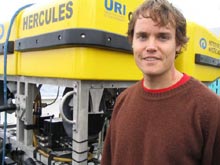
Brian Bingham, ROV navigator, post-doc, Woods Hole Oceanographic Institute. Image courtesy of M. Grady.
Brian Bingham: I was a graduate student in mechanical engineering at MIT [Massachusetts Institute of Technology], and interested in robotics. My adviser, David Mindell, works with this project at WHOI [Woods Hole Oceanographic Institute]—so I got involved. I finished my PhD last spring, and I was on last summer's trip to the Black Sea. After this trip, I have two other cruises this summer working with autonomous underwater vehicles.
Ocean Explorer: It's getting a bit windy and wavy today. What are the parameters for launching the ROVs?
Brian Bingham: We don't really know yet. This is only the second time we've used them. Last summer, we were in the Mediterranean, where it's beautiful, and the Black Sea, which is a lake. So far this year we've been really lucky with the weather. So we'll have to see.
Ocean Explorer: The ROVs will go much deeper on this trip than they have before, right?
Brian Bingham: Yes, we've already gone deeper than we did last year. Going to 4,000 meters will be a challenge to the navigation system, because the signal degrades with distance.
Interview with Mary Grady
Interview by Lance Arnold of the Ocean Explorer Team
Ocean Explorer: Tell us about your educational background.
Mary Grady: I've always been interested in nature and how it works, how people interact with the natural world, and environmental issues. These interests led me to major in geography as an undergraduate. I studied at the University of Rhode Island and Rhode Island College, and then got a master's degree in geography at the University of Hawaii. Shortly after finishing there, I went to National Geographic in Washington D.C. as a geography intern, and I worked there for two years as an editor in the book division.
Ocean Explorer: What kind of courses do you teach, and how did you get involved with this research cruise?
Mary Grady: Most of my courses are science electives for non-science majors. So I try to expose them to some of the basic principals: how science works, how nature works, and how to think analytically. I taught marine geography aboard the tall ship Rose, which used to be docked in Bridgeport before it moved to Hollywood. I heard about the Mountains in the Sea expedition when I was teaching introductory oceanography at Northeastern University, and here I am.
Ocean Explorer: What do you think this trip will do to enhance your educational work?
Mary Grady: Since all of my teaching is as an adjunct at three different schools, I don't get a lot of chances to interact with other educators or researchers. I just go to campus and teach my class and leave. So this is a real treat to be at sea, to be looking over the shoulders of all these scientists, to get a feel for what they are doing, and also to be interacting with them and the OE [Ocean Explorer] staff as educators.
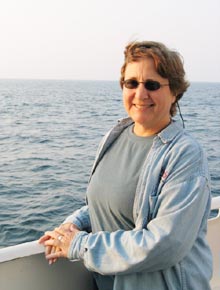
Mary Grady, adjunct instructor, department of Earth science, Boston's Northeastern University. Image courtesy of L. Arnold
Ocean Explorer: You are taking great pictures and writing a lot while on board. Tell us about that.
Mary Grady: For most of my career, I've earned my living as a writer and editor. I've learned a lot about photography from the talented photo editors I worked with at National Geographic and the Providence Journal, where I was a news editor for six years. As a freelancer, I'm able to combine all those skills—writing, photography, teaching —to create a sort of custom-designed career, where I can pursue my own ideas and set my own goals. Besides teaching, I write and shoot pictures for magazines, newspapers, and the Internet. While on this expedition, I am writing daily logs for projo.com, the Web site of the Providence Journal, in addition to writing for the OE Web site.
Ocean Explorer: What advice would you give to a student who wants to be a writer or photographer?
Mary Grady: Read the classics—Conrad is my favorite—or whoever it is that inspires you. Go to museums and look at all kinds of art. Find your own way in the world, think for yourself, and have something to say.
Interview with Katie Olds
Interview by Mary Grady of the Ocean Explorer Team
Ocean Explorer: What are you studying in school?
Katie Olds: I'm in a liberal arts program at the Honors College at Florida Atlantic University, in Jupiter. I have a biology concentration and an environmental studies minor. I spent the spring term at Harbor Branch, where they have a semester-by-the-sea program. I took 19 credits and I learned so much! The semester before that I had taken a course with Dr. [Jon] Moore in marine biology. He's my adviser.
Ocean Explorer: How did you come to be on this expedition?
Katie Olds: Last year, Dr. Moore gave a talk about his work on this expedition, and he said there might be opportunities for students to go along. So I followed him out of the room and practically stalked him, until I got a chance to ask him about it and how to apply. He said he would keep me in mind if there were openings. Then, a couple months ago, he said I could go.
Ocean Explorer: How did you get interested in marine science?
Katie Olds: I grew up in Florida, near the coast, and I was always involved in sailing and scuba diving. And I liked biology in high school.
Ocean Explorer: Where do you plan to go from here?
Katie Olds: I finish my coursework next spring, then I need to write a thesis. I might work with Dr. Moore over the summer to build a media library. Then I'd like to intern at Harbor Branch, to complete my environmental studies requirements. And I'd like to spend a semester or two at James Cook University, in Australia. It's really well-known for oceanography and exploration. Then, I want to go on for my master's or PhD, definitely. I'd love to work in environmental science, because you get to travel and go to really cool places. It's a lot of fun.
Ocean Explorer: How are you enjoying this trip so far? Are you working hard?
Katie Olds: Yes, but I knew I would be. It's great. I love it!
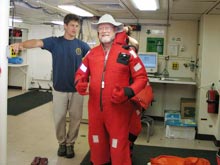
Tolland High School teacher Lance Arnold tries on a survival ("Gumby") suit during ship safety drills, with the assistance of Ronald H. Brown executive officer Mike Hoshlyk. Image courtesy of M. Grady
Interview with Lance Arnold
Interview by Mary Grady of the Ocean Explorer Team.
Ocean Explorer: What is your educational background?
Lance Arnold: I graduated from American International College in Massachusetts and taught for two years, and then received a NSF Academic Year grant for my master’s degree at Chapel Hill, North Carolina. Later, I received a sixth year degree from Southern Connecticut State University. I have been a life science teacher for 37 years and have a special interest in marine sciences.
Ocean Explorer: What is your experience in education and marine sciences?
Lance Arnold: I’m heavily involved in marine education stuff. I’m a board member of SENEME, the South Eastern New England Marine Educators, and have coached a National Ocean Sciences Bowl team for several years. I have been taking high school students to the Bermuda Biological Station for Research for over 30 years to do field work. I have also trained teachers to use the opportunities available at the station.
Ocean Explorer: What will be the impact of this trip on your work?
Lance Arnold: It is really exciting to see scientists do what they do. The social interaction, the professionalism, the organizational skills, the huge range of talents—from computer skills to grant writing to video tech—all come together for them to study their subject. I’ve also been amazed at the very real desire for these scientists to draw students and educators into a deeper understanding of what science is like as a career. This is not a secondary aspect of this trip; in many ways, it is one of the major reasons for this expedition. [NOAA's Office of] Ocean Exploration has recognized that the best way to get students excited about marine science is to get their teachers excited. This has certainly worked for me, and I know it will for my students. I’ve already received emails from some of my students.
Ocean Explorer: Tell me about your artwork and how it relates to your work here.
Lance Arnold: I have been doing art all my life, but this is the first time that I have been able to really apply my artistic skills in the pursuit of science. On this expedition, I’ve made illustrations to be used as teaching tools in live Webcasts. I've also been drawing fast sketches of deep-sea coral branches, as they are collected by the ROV Hercules, to help identify them when they arrive on deck. I’ve been recording the growth patterns and spatial relationships of corals, and I’ve enjoyed learning to use my new digital camera.
Ocean Explorer: What can you take home to students?
Lance Arnold: The first thing is my excitement! I will have pictures, maybe some coral samples, and stories to tell of how scientists and educators work together and apart in professional ways to increase our understanding of the oceans and their organisms. The writing, which is one of the responsibilities for me on this trip, has forced me to organize my thinking about how I feel about science, education, and my life.
Ocean Explorer: What would you say to kids?
Lance Arnold: Often, high school students don’t know what they want to do. Parents sometimes pressure kids to make decisions they may not be ready for. You don’t have to choose your career, or life, in high school, but you do have to prepare well for as many possibilities as you might want to consider in the future. If you can say you are interested in science and nothing more, then grab all the math and science and communication skills you can. Being prepared to learn is important.
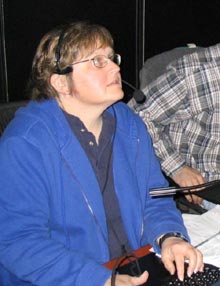
Ruth Gibbons joined the team to collect data on cephalopods and to bring it back to the lab for analysis. Image courtesy of M. Grady
Interview with Ruth Gibbons
Interview by Mary Grady of the Ocean Explorer Team
Ocean Explorer: What is your role on this cruise?
Ruth Gibbons: I'm here mainly to collect images of cephalopods—squid and octopus, etc.—and bring them back to the lab in Washington, D.C., where a scientist on staff will study them. Mainly, these are for the use of Dr. Michael Vecchione at the National Systematics Lab. I'll stand watches in the control room—from 4 to 8, twice a day, every day—and keep logs of what comes in over the video feed. Then I will take the collection of images back to Dr. Vecchione.
Ocean Explorer: Have you been on a lot of these cruises, doing this kind of work?
Ruth Gibbons: I've been on about 10 of them over the 22 years that I have worked for NOAA. I also do administrative work for the lab, so it's not always easy to get away. Now we have more staff, so I'm able to get out to sea more often. I have been on cruises that my lab organized to the Gulf of Maine and to Bear Seamount. I have also gone on NEFSC fish surveys. A week after we return from this trip, I am going on a deep-water systematics cruise at the Bear Seamount. That's pretty unusual, to get two trips to the same place so close together.
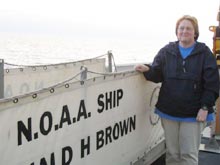
Research assistant Ruth Gibbons works for NOAA National Systematics Lab and the National Museum of Natural History. Image courtesy of M. Grady
Ocean Explorer: How did you get started in this line of work?
Ruth Gibbons: When I was a biology student, I worked for the Smithsonian, helping them to inventory the large fish specimens in their tank collection. When we did the family Scombridae [tunas, etc.], I worked with Dr. Bruce Collette of the NMFS NSL, who is an expert on the family. When the lab's research assistant retired, I got that job.
Ocean Explorer: Can you tell us more about what your work on board here will involve?
Ruth Gibbons: Not yet, because it's all new to me. I've never even seen one of these ROVs before. So I'll just wait and see. Whatever help they need, I'll be happy to do it.
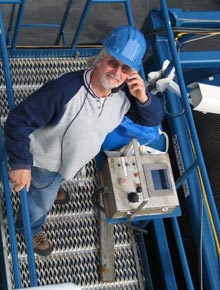
Tom Orvosh at the huge winch, which raises and lowers the Argus sled and the ROV Hercules. The cable has a fiber optic center for communication to the underwater vehicles and for video feeds back to the surface.
Interview with Tom Orvosh
Interview by Mary Grady of the Ocean Explorer Team
Ocean Explorer: What is your background, and why are you on this trip?
Tom Orvosh: I went to Southern Maine Vocational and Technical Institute in the 1970s in a two-year Sea Grant program in applied oceanography and marine biology. It was a broad-based program for data sampling, biological identification, and field equipment operation (both electrical and mechanical), from corers to salinometers. I had a background as a diver and loved the ocean, so I wanted to do something with the ocean.
Ocean Explorer: What were some steps along the way?
Tom Orvosh: I worked for three years on the Hudson River estuary system as part of a field biological support team for scientists studying the impact of nuclear power plants on the Hudson River fishery.
Ocean Explorer: What kinds of fish were you interested in?
Tom Orvosh: Shad, sturgeon, striped bass, white perch…but striped bass were the most important due to the major fishery interests.
Ocean Explorer: What was your next job?
Tom Orvosh: I became coordinator for the whole field operations team doing environmental studies.
Ocean Explorer: How did you get to the ocean?
Tom Orvosh: An estuary is part of the ocean ecosystems.
Ocean Explorer: How about the open ocean, such as where we are here in the mid-Atlantic?
Tom Orvosh: I returned to college when I was 28 years old to the University of Rhode Island, majoring in electrical engineering, and my interest remained in marine instrumentation. In a work-study program, I got to be a support tech with the physical oceanography group there.
Ocean Explorer: So, you’re getting closer to the ocean.
Tom Orvosh: I worked three summers and after school on ocean research cruises and after getting my BS degree, I was hired as a research associate for physical oceanography at URI and then transferred to ship operations on the R/V Endeavor, URI's research vessel.
Ocean Explorer: What do you do now?
Tom Orvosh: I’m 25 percent ship support team and 25 percent on campus tech support, including sea water aquarium systems, and audio/visual systems for the Coastal Institute at URI, which includes work for the JASON Project. The rest of my time has been on Bob Ballard’s ROV exploration team, traveling to areas around the world—the Great Lakes, the Black Sea, the Mediterranean, and this Mountains in the Sea expedition. Next, I will be returning to the Titanic with the Ballard exploration team.
Ocean Explorer: What would you say to students who want to do what you do?
Tom Orvosh: Get your math and science and computer skills. Learn as much as you can. Develop your hands-on skills by taking things apart to see how they work, put them back together, repair them. Just get familiar with how things are made and tested. There are many companies that will train you, there are tech schools, and there are colleges all for marines sciences that are looking for students with an interest in marine application. But they want to see somebody who can have the skills and confidence to work in all kinds of weather, under timeline pressures, to ensure a successful mission.
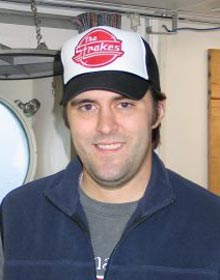
Mike McKee, NURC IT specialist, and Mountains in the Sea 2004 data manager. Image courtesy of L. Arnold
Interview with Mike McKee
Interview by Lance Arnold of the Ocean Explorer Team
Ocean Explorer: What’s your educational background, and why are you on this trip?
Mike McKee: I have an undergraduate degree in zoology and anthropology from Miami University and a master’s degree in oceanography from the University of Connecticut. What brought me here is that I pursued a position at NURC [National Undersea Research Center] and got a job archiving and analyzing video from undersea research from the past 20 years. In the process I’ve learned a lot about database development and Web programming. Through a collaboration with NOAA’s Office of Ocean Exploration, I’ll be serving in the role of data manager for this expedition.
Ocean Explorer: What does that role entail?
Mike McKee: Oversight and management of the collection of video data and still imagery, navigation data, and the collection of live specimens during the deployment of the ROV. We will be tracking activities on the ship, such as ROV dives, multibeam sonar mapping, and live video Webcasts. I will also gather raw data and direct it to appropriate scientific parties as well as tracking it in the NOAA Expedition Information System [EIS].
Ocean Explorer: What is the Expedition Information System?
Mike McKee: EIS is a database developed for Ocean Exploration through a NOAA collaborative effort. The database is designed to log metadata associated with virtually everything that happens from the time we leave port to the time we return from expedition. In order to do this, we have two terabytes of data storage capacity in addition to more than 200 digital videos (some of which are high definition) and over 1,000 DVDs.
Ocean Explorer: What are your future goals?
Mike McKee: Part of my reason for being here is the excitement of the scientific and explorative nature of oceanography. I enjoy assisting researchers with the technology that enables the scientists to conduct their research. I hope to conduct research of my own in the future.
Ocean Explorer: What would you like to say to a high school student?
Mike McKee: I always wanted to be a marine scientist or oceanographer. Living in the Midwest people questioned my goals, but I’ve come to learn I’m a salty dog after all!
Interview with Kari Heinonen
Interview by Lance Arnold of the Ocean Explorer Team.
Ocean Explorer: What is your education background and why are you on this trip?
Kari Heinonen: I graduated from Eastern Connecticut State University in 2001 with degrees in biology and chemistry. I studied tropical island ecology in Bermuda at the Bermuda Biological Station for Research and in San Salvador at the Bahamian Field Station through ECSU’s tropical biology program. Currently, I’m finishing my masters and starting my PhD in biological oceanography at University of Connecticut. On this trip, Dr. Peter Auster and I will be looking at fish abundance, diversity and behavior within the context of the sea floor landscape of the seamounts.
Ocean Explorer: What will your personal role be?
Kari Heinonen: I’ll be recording fish species–when and where they occur–during the ROV Hercules transects. Later, I’ll be analyzing all the data we collect during this cruise.
Ocean Explorer: What are some of your expectations?
Kari Heinonen: There isn’t much known regarding the fish abundance and diversity in seamount environments, and even less is known about the habitats in which they occur and their behavior. I’ve seen videos from last year’s cruise, so I’m very excited to see some of the species in real time. It will be interesting to see how the fish interact with their environment.
Ocean Explorer: In general, what kinds of habitats exist?
Kari Heinonen: From the videos I’ve seen, mud and basalt are the most common sea floor habitats, but these can be broken down into other categories. There is a hierarchical system for classifying habitats based on geomorphology.
Ocean Explorer: That description is pretty physical. What are the biological aspects?
Kari Heinonen: Other sea floor habitats may include pteropod ooze and coral rubble. There is some video showing fish associated with structures, like corals growing on the basalt.
Ocean Explorer: How do you analyze data? What is that process?
Kari Heinonen: I pull all of the photos containing an individual fish from files containing a large number of stills from the transects, and I identify the fish and its habitat. Then in video analysis, I record times codes—the “start time” we see a fish, and the “end time” when we no longer see the fish—and identify all fish in the video, what the habitat type is, and their behaviors.
Ocean Explorer: How will this data be used?
Kari Heinonen: This will help us understand fish diversity on the seamounts and how fish behave within the context of a certain landscape. This is cutting-edge science.
Ocean Explorer: What are your long term goals?
Kari Heinonen: The research I’m doing on this trip is a way of exposing me to a field that I don’t investigate in my personal studies. It is very interesting and I’m excited to be on this cruise learning about other areas of marine ecology. My dissertation research doesn’t focus on seamount ecology, but instead on the potential impacts of invasive crab species on coastal food webs of Long Island Sound.
Ocean Explorer: That sounds interesting and exciting.
Sign up for the Ocean Explorer E-mail Update List.















